Review MegaFon SP-W1 on Windows Phone 7.5
Honestly, when I was preparing this review, I did not know that they would ask me to put it on Habrahabr. Therefore, I ask you not to punish me strictly: my photos, opinions and assessments can easily turn out to be unprofessional and subjective.
So, MegaFon SP-W1 is a smartphone from MegaFon. This is their first device under Windows Phone 7.5, and also the cheapest (8900 rubles) in this MegaFon lineup . Before coming to Russia and becoming an SP-W1, this phone was beautifully called ZTE Tania .
A little about the characteristics of the device:

If you analyze them, it becomes approximately clear for what and for whom this phone is intended. The SP-W1 does not have an additional memory card slot (despite the fact that only 2 GB is allocated to the user), but it supports high-speed data transmission of the HSPA + standard (faster than 3G) and has a rather simple operating system with a noticeable bias towards social networks.
')
Obviously, users of iOS and Android can hardly even think about such a purchase. But for a not very sophisticated user who needs ICQ, Mail.ru, VKontakte and Skype, this relatively inexpensive smartphone can be just a godsend, because Android is more complicated to set up and manage, and iOS devices are almost 3 times more expensive.
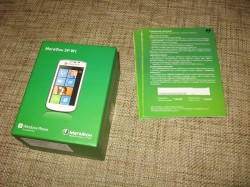

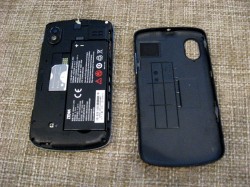

There is nothing unusual in the configuration; the most valuable thing there is a battery and a USB cable for connecting to a PC. Headset and charger are very formal.
The frame around the screen is metal, the back panel is plastic (soft-touch). To remove this panel according to the instructions and the first time - the task is not easy, it is assembled very tightly.
The smartphone is big. In pockets, of course, fits, but still big. However, in the hand is normal, and when browsing Internet sites, the size on the contrary seems to be a good advantage.
The camera on the back panel is not protected by anything, the microUSB connector is also without a latch. My superbudgetary Samsung Star II dialer (for 4,000 rubles) has a latch, although it does not automatically close. Connectors, by the way, are identical.

Even on the assembly, I can only find fault with the camera button: on the new phone it is tight, which is why at the time of the shooting it is necessary to make an effort. At this point, the phone is slightly shifted, the frame is washed. However, you can not use it, but click on the screen.
Describing a smartphone, it is very difficult to describe the device itself, and not its operating system. Therefore, I will try to focus on the hardware: screen, buttons, camera, connection.
The screen of the SP-W1 is wonderful. The iPad has a slightly brighter screen, but there is no noticeable difference when working. Typing is convenient, it turns out pretty quickly. I did not notice any inconvenience associated with the screen when using a smartphone, so I’ll stop on that.
Below the screen there are three standard buttons - “Back”, “Windows” (returns to the desktop) and “Search” (opens Bing in the browser). It would be great to be able to hang another function on the third button, but this seems to be a limitation of the operating system. Touch buttons, when pressed, the phone gives a short vibration signal - convenient, understandable.
The camera of the device takes pictures in the resolution of 2592 × 1944 pixels, is equipped with a single-section LED flash. Yes, there is an application "Flashlight".
I will compare the work of the camera with what I found in the desk drawer:
Service Habrastorage all original images courtesy of 800x600.
Test One : Medium Illumination, LED. No flash.
Test two : the lighting is the same. With flash (Star II has no flash).
You can see how the flash "blinds" the SP-W1 camera up close.
Test three : lighting - natural, cloudy weather.
Fourth test : the lighting is weak, LED. No flash.
Test five : the lighting is very weak. No flash.
Test six : conditions are the same, macro mode is on. Star II is missing.
It should be noted that all the pictures were taken without changing the settings, that is, in conditions that are real, because the program for photography in Windows Phone 7.5 is loaded in the standard settings and there is usually no time to change them. But in general, the brightness, contrast and ISO in the camera settings of this smartphone are regulated strongly, in all directions and with diverse results. Brightness for some reason always want to set higher.
I don’t know how and how to explain it, but the camera in MegaFon SP-W1 takes pictures that are subjectively more natural, softer, in warmer and more pleasant looking colors. At least I personally liked his camera.
Communication with this smartphone is a strong point. I will not even talk about GSM (calls, SMS, MMS), now everyone is able to do that, everything is also on the level.
Interest in the device is HSPA + technology. It is something like “overclocked” 3G and promises subscribers a maximum theoretical data transfer rate of up to 14.4 Mbit / s. It promises, however, only to subscribers in a fixed state and in close proximity to the base station.
It was easier to compare: there is an iPad with a full-fledged 3G on hand (and also a MegaFon SIM card) . Tests were carried out in the city center, in the apartment. The speed was measured by the only identical program that has a version for both iOS and WP 7.5 - QIP Speed Test. Just in case, I measured the speed with several more programs - the numbers were in the same range.
Both on average and on maximum download speed, the iPad lost almost 2 times.
This will definitely provide greater speed in working with applications that need to communicate with the global network. But when using the browser there is no double acceleration - IE and Safari display large and complex pages with almost the same speed.
The test conclusion I would do is this: the device is definitely useful. Especially when it is too lazy to carry an iPad with you, but on the Internet something may suddenly be needed.
The lack of memory expansion is not particularly critical, since the speed of access to the network is high, and “thin clients” are generally the right way.
The inability to change the operator is slightly costly in terms of voice communication, but is compensated by the high data transfer rate.
So, MegaFon SP-W1 is a smartphone from MegaFon. This is their first device under Windows Phone 7.5, and also the cheapest (8900 rubles) in this MegaFon lineup . Before coming to Russia and becoming an SP-W1, this phone was beautifully called ZTE Tania .
A little about the characteristics of the device:

- The processor - 1 GHz (Qualcomm MSM8255)
- RAM - 512 MB
- Built-in memory - 4 GB (of which 2 GB is available to the user)
- Display - multitouch 4.3 '', 480 × 800 px
- Camera - 5 megapixel, flash, 720p video recording
- 3G (HSPA +), Wi-Fi, Bluetooth, GPS, FM Radio
- G-sensor, proximity sensor
- 3.5 mm headphone jack, microUSB connector
- 1400 mAh battery
- Size 67.8 × 128.6 × 10.7 mm, weight 158 g
- It works only with MegaFon SIM cards.
If you analyze them, it becomes approximately clear for what and for whom this phone is intended. The SP-W1 does not have an additional memory card slot (despite the fact that only 2 GB is allocated to the user), but it supports high-speed data transmission of the HSPA + standard (faster than 3G) and has a rather simple operating system with a noticeable bias towards social networks.
')
Obviously, users of iOS and Android can hardly even think about such a purchase. But for a not very sophisticated user who needs ICQ, Mail.ru, VKontakte and Skype, this relatively inexpensive smartphone can be just a godsend, because Android is more complicated to set up and manage, and iOS devices are almost 3 times more expensive.




There is nothing unusual in the configuration; the most valuable thing there is a battery and a USB cable for connecting to a PC. Headset and charger are very formal.
The frame around the screen is metal, the back panel is plastic (soft-touch). To remove this panel according to the instructions and the first time - the task is not easy, it is assembled very tightly.
The smartphone is big. In pockets, of course, fits, but still big. However, in the hand is normal, and when browsing Internet sites, the size on the contrary seems to be a good advantage.
The camera on the back panel is not protected by anything, the microUSB connector is also without a latch. My superbudgetary Samsung Star II dialer (for 4,000 rubles) has a latch, although it does not automatically close. Connectors, by the way, are identical.

Even on the assembly, I can only find fault with the camera button: on the new phone it is tight, which is why at the time of the shooting it is necessary to make an effort. At this point, the phone is slightly shifted, the frame is washed. However, you can not use it, but click on the screen.
Describing a smartphone, it is very difficult to describe the device itself, and not its operating system. Therefore, I will try to focus on the hardware: screen, buttons, camera, connection.
Screen
The screen of the SP-W1 is wonderful. The iPad has a slightly brighter screen, but there is no noticeable difference when working. Typing is convenient, it turns out pretty quickly. I did not notice any inconvenience associated with the screen when using a smartphone, so I’ll stop on that.
Buttons
Below the screen there are three standard buttons - “Back”, “Windows” (returns to the desktop) and “Search” (opens Bing in the browser). It would be great to be able to hang another function on the third button, but this seems to be a limitation of the operating system. Touch buttons, when pressed, the phone gives a short vibration signal - convenient, understandable.
Camera
The camera of the device takes pictures in the resolution of 2592 × 1944 pixels, is equipped with a single-section LED flash. Yes, there is an application "Flashlight".
I will compare the work of the camera with what I found in the desk drawer:
- The aforementioned Samsung Star II with a 3.2 megapixel camera.
- Canon PowerShot A550 Soap Dish Class Camera with 7.1 MP
Service Habrastorage all original images courtesy of 800x600.
Test One : Medium Illumination, LED. No flash.
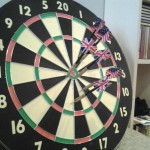 | 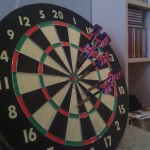 | 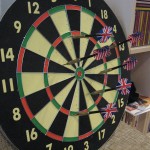 |
| Samsung Star II | MegaFon SP-W1 | Canon A550 |
Test two : the lighting is the same. With flash (Star II has no flash).
 | 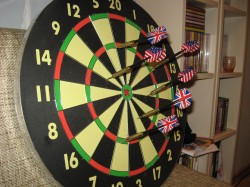 |
| MegaFon SP-W1 | Canon A550 |
You can see how the flash "blinds" the SP-W1 camera up close.
Test three : lighting - natural, cloudy weather.
 |  |  |
| Samsung Star II | MegaFon SP-W1 | Canon A550 |
Fourth test : the lighting is weak, LED. No flash.
 | 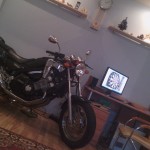 |  |
| Samsung Star II | MegaFon SP-W1 | Canon A550 |
Test five : the lighting is very weak. No flash.
 |  |  |
| Samsung Star II | MegaFon SP-W1 | Canon A550 |
Test six : conditions are the same, macro mode is on. Star II is missing.
 |  |
| MegaFon SP-W1 | Canon A550 |
It should be noted that all the pictures were taken without changing the settings, that is, in conditions that are real, because the program for photography in Windows Phone 7.5 is loaded in the standard settings and there is usually no time to change them. But in general, the brightness, contrast and ISO in the camera settings of this smartphone are regulated strongly, in all directions and with diverse results. Brightness for some reason always want to set higher.
I don’t know how and how to explain it, but the camera in MegaFon SP-W1 takes pictures that are subjectively more natural, softer, in warmer and more pleasant looking colors. At least I personally liked his camera.
Connection
Communication with this smartphone is a strong point. I will not even talk about GSM (calls, SMS, MMS), now everyone is able to do that, everything is also on the level.
Interest in the device is HSPA + technology. It is something like “overclocked” 3G and promises subscribers a maximum theoretical data transfer rate of up to 14.4 Mbit / s. It promises, however, only to subscribers in a fixed state and in close proximity to the base station.
It was easier to compare: there is an iPad with a full-fledged 3G on hand (and also a MegaFon SIM card) . Tests were carried out in the city center, in the apartment. The speed was measured by the only identical program that has a version for both iOS and WP 7.5 - QIP Speed Test. Just in case, I measured the speed with several more programs - the numbers were in the same range.
- iPad, 3G: average download speed (12 measurements) - 3.03 Mbit / s, maximum - 4.20 Mbit / s.
- SP-W1, HSPA +: average download speed - 5.73 Mbit / s, maximum - 7.25 Mbit / s.
Both on average and on maximum download speed, the iPad lost almost 2 times.
This will definitely provide greater speed in working with applications that need to communicate with the global network. But when using the browser there is no double acceleration - IE and Safari display large and complex pages with almost the same speed.
The test conclusion I would do is this: the device is definitely useful. Especially when it is too lazy to carry an iPad with you, but on the Internet something may suddenly be needed.
The lack of memory expansion is not particularly critical, since the speed of access to the network is high, and “thin clients” are generally the right way.
The inability to change the operator is slightly costly in terms of voice communication, but is compensated by the high data transfer rate.
Source: https://habr.com/ru/post/155775/
All Articles